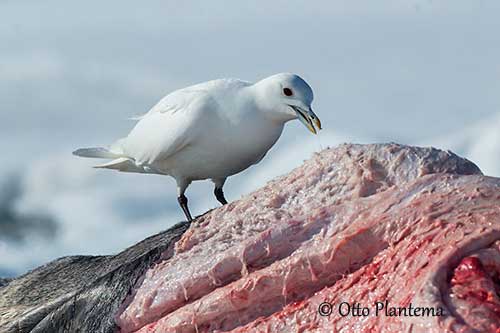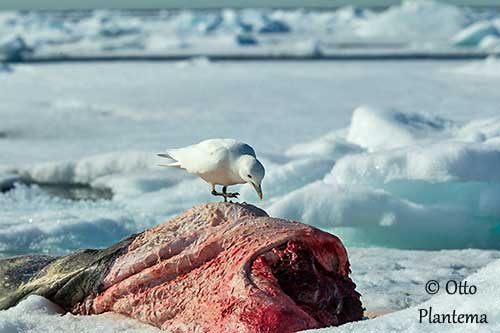
Fr: Mouette blanche
Ang: Ivory Gull
All: Elfenbeinmöwe
Esp: Gaviota Marfileña
Ita: Gabiano ebureno
Nd: Ivoormeeuw
Sd: Ismås
Photographers:
Didier Buysse
Vision d’Oiseaux
Otto Plantema
Trips around the world
Text by Nicole Bouglouan
Sources:
HANDBOOK OF THE BIRDS OF THE WORLD Vol 3 by Josep del Hoyo-Andrew Elliott-Jordi Sargatal - Lynx Edicions - ISBN : 8487334202
THE HANDBOOK OF BIRD IDENTIFICATION FOR EUROPE AND THE WESTERN PALEARCTIC by Mark Beaman, Steve Madge - C. Helm - ISBN: 0713639601
L’ENCYCLOPEDIE MONDIALE DES OISEAUX - Dr Christopher M. Perrins - BORDAS - ISBN: 2040185607
SeaWeb – Leading Voices for a Healthy Ocean
Spitsbergen – Svalbard Information
All About Birds (Cornell Lab of Ornithology)
Bird Web (Seattle Audubon Society)
What Bird-The ultimate Bird Guide (Mitchell Waite)
Wikipedia, the free encyclopaedia
Summary Cards
Ivory Gull
Pagophila eburnea
Charadriiformes Order – Laridae Family
INTRODUCTION:
The Ivory Gull is an all-white bird with stocky body and short legs involving rolling gait. This species is a scavenger and is often aggressive while chasing larger gulls away.
It is the only member of the genus Pagophila, due to morphological features and behavioural and ecological differences from other close species.

DESCRIPTION OF THE BIRD:
Biometrics:
Length: 44-48 cm
Wingspan: 108-118 cm
Weight: 520-700 g
The adult has striking pure white plumage overall.
The bill is blue-grey with yellow tip. The eyes are blackish. Legs and webbed feet are black.
Male and female are similar.
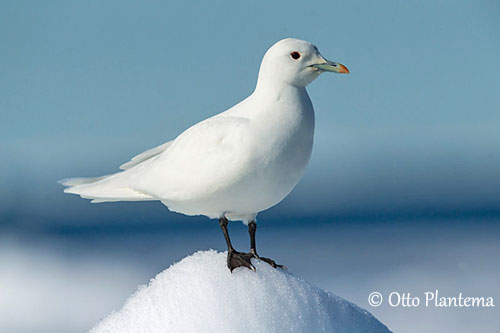
The juvenile/immature has white plumage with black spots on breast and flanks. Primaries, outer wing-coverts and rectrices are black-tipped. However, the extent of black speckles varies among individuals. It has dusky face, including the area around the eye. The bill is duller than in adult.
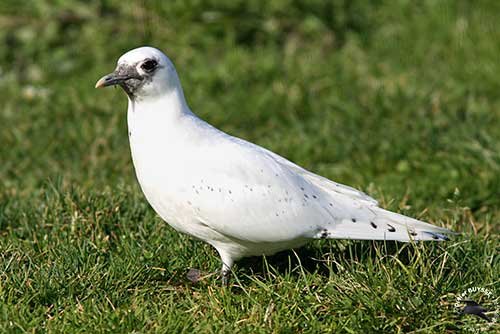
RANGE:
The Ivory Gull has circumpolar breeding range across the high Arctic. The colonies are scattered and can be found in arctic Canada, Greenland, Svalbard, Franz Josef Land, Novaya Zemlya and Severnaya Zemlya, New Siberian Islands and Herald Island.
It winters mainly around Baffin Island, Davis Strait, Labrador Sea, SE Greenland and Bering Strait area.
HABITAT:
The Ivory Gull breeds on steep cliffs near the pack ice, on broken ice fields, on rocks or flat shoreline, all sites usually close to open water. It may nest from sea-level up to 800 metres of elevation.
Outside the breeding season, it can be found in areas of pack ice, or open water surrounded by ice.
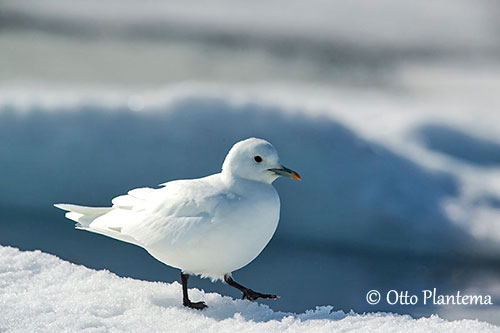
CALLS AND SONGS: SOUNDS BY XENO-CANTO
The Ivory Gull gives tern-like, harsh calls including grating “kriiaah” and piercing “kree-kree”. We can also hear some whistling “psieooe”.
BEHAVIOUR IN THE WILD:
The Ivory Gull is an opportunistic feeder like numerous Laridae species. It feeds primarily on fish, shrimps and shellfish, but it also takes algae, carrion, offal, animal faeces and seal placenta.
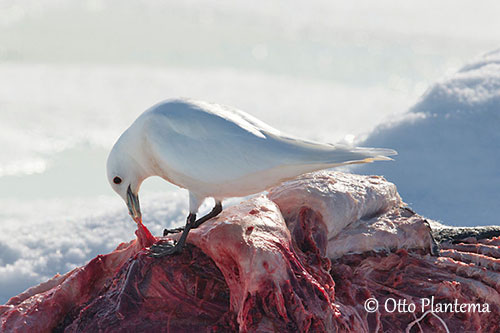
It forages within drift ice areas and is mainly a surface-feeder. It feeds by hovering on open water and dipping. Marine crustaceans are caught by surface-dipping while flying.
It often follows the polar bears and takes advantage of their preys, feeding on scraps from their kills.
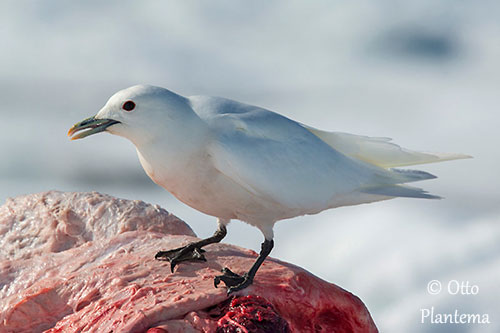
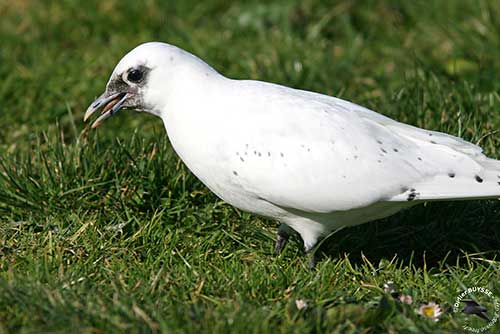
The Ivory Gull is gregarious and breeds in colonies. Due to extreme cold weather, they remain relatively inactive during most of the breeding cycle to reduce energy expenditure while rearing the chicks.
The courtship displays are typical of Laridae, with tossing head back with the bill pointing upwards, and lowering the head while giving plaintive notes. They also give long calls. The male feeds the female with regurgitated food during the displays.
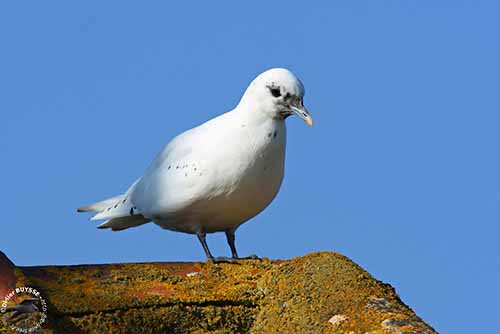
The Ivory Gull leaves the colonies in late August/early September, and reaches the sea ice edge between Svalbard and Severnaya Zemlya in Russia. Later, in mid-October, they migrate to their wintering grounds along the ice edge between Canada and Greenland, in the Labrador Sea. They leave the wintering areas in April and reach the breeding areas in May.
The Ivory Gull has fast, graceful and agile flight, performed with effortless strong wingbeats.
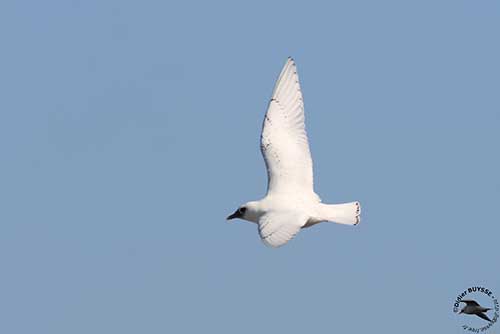
REPRODUCTION OF THIS SPECIES:
The breeding season varies from late March in Svalbard, to April at Franz Josef Land, and to late May in Canadian Arctic and N Greenland.
The Ivory Gull nests usually on narrow rocky ledges or in a depression in gravel or on flat rocky ground. The nest is built by both adults. It is made with various plant materials such as seaweeds, moss and debris. The shallow cup is lined with dry grass and feathers.
The Ivory Gull breeds in colonies of 5-60 pairs, up to 100 sometimes, but rarely in isolated pairs. Within the colonies, the nests are about 120 centimetres apart or more, up to 100 metres, depending on the area.
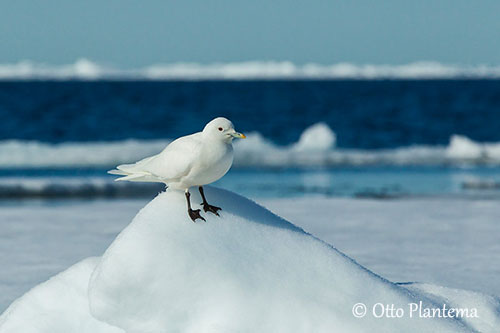
The female lays 1-2 grey-brown eggs with dark brown speckles. Both parents share the incubation during 25 days. At hatching, the chicks have pale grey down above, with some indistinct grey streaks on the wings. The underparts are white with pale grey patch on belly. They are fed by both parents, and brooded during the first days. They fledge about 5-7 weeks after hatching.
Both adults and young disperse very soon after breeding to offshore foraging areas.
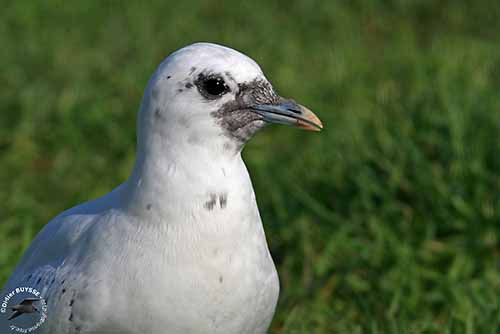
PROTECTION / THREATS / STATUS:
The Ivory Gull is affected by heavy predation during the nesting period. Arctic foxes can destroy entire colonies in flat areas. Eggs and young birds are sometimes taken by polar bears, and more often by Glaucous Gulls.
This species is threatened by climate change involving more severe winters and changing sea-ice movements and thickness, illegal hunting in Canada, oil-spills at sea and disturbance at colonies due to increase of diamond exploration. In addition, toxic pollutants involve various levels of concentration of mercury in the eggs, especially on Seymour Island, Canada, like PCB and DDT in other areas. The Ivory Gull is the most affected seabird, compared to other gull species of Arctic regions.
The global population is estimated to number 19,000/27,000 individuals, equivalent to 12,000/18,000 mature individuals. Declines are reported in several parts of the range.
The Ivory Gull is currently considered Near Threatened.
